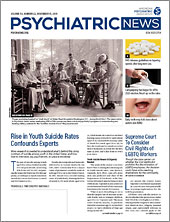Rarely is the impact of stigma against people with mental illness more evident than when an incident of mass violence sparks assumptions about the perpetrator’s mental health.
The public perception that those with mental illness are potentially violent has generally increased over the last 22 years, particularly for schizophrenia, as has support for coercive treatment, according to a study published in the October Health Affairs.
“If society does not attempt to counter the drift toward greater public stigma of dangerousness and support for coercion, the damage to people with mental illness, their families, the mental health system, and society can only worsen,” wrote lead author Bernice Pescosolido, Ph.D., a distinguished professor of sociology at Indiana University, and colleagues.
The authors examined trends from three National Stigma Studies, which Pescosolido and her colleagues developed. The studies consisted of vignettes that described profiles of hypothetical people with symptoms or behaviors of psychiatric disorders meeting DSM-IV criteria. They were included in the 1996, 2006, and 2018 General Social Survey, which measures attitudes, beliefs, and behaviors in American society and is conducted by the National Opinion Research Center at the University of Chicago.
The vignettes were meant to test the respondents’ ability to recognize mental illness and gauge whether they associated mental illness with danger, as well as their willingness to respond to it with coercion. In 1996 there were 1,444 respondents and a 76.1% response rate; in 2006 there were 1,522 respondents with 71.2% response rate; and in 2018 there were 1,173 respondents with a 59.5% response rate.
The vignettes described people with schizophrenia, alcohol dependence, and major depression. A fourth described nonclinical “daily troubles,” which essentially involved a person who felt worried, sad, and had trouble sleeping at night but was “getting along pretty well,” the vignette stated. Respondents were randomly assigned one vignette. An interviewer read them the vignette, and they received a printed copy. They then responded to questions.
“The public perception of the likelihood that people with mental illness will be violent toward others was high, consistently approaching or exceeding 60% for both schizophrenia and alcohol dependence,” the study found.
Other key findings include the following:
•
Over 30% of 2018 respondents saw vignette characters with major depression as likely to be violent toward others.
•
Respondents who reported that people with depression or daily troubles were more likely to harm themselves increased over all three years.
•
Between 40% and 60% of respondents supported all forms of legal forced treatment for schizophrenia in 2018.
•
Between 1996 and 2018, support for coercive hospitalization for schizophrenia increased by over 10%.
The authors wrote that one of the most troubling findings was that nearly 20% of respondents in 2018 were willing to use the law to put a person with daily troubles in a psychiatric hospital. That was a significant increase over the 2006 and 1996 responses. “What it tells me is that right now we’re living in a very fearful society,” Pescosolido said.
“The myth of dangerousness is deep in our culture,” she continued. She noted how, after a mass shooting, she usually hears comments that the perpetrator was “sick.” “But ‘sick’ does not mean mentally ill,” she said. “It’s sort of our American metaphor for anybody who is outside the norm.”
Some of the study findings, the authors noted, could be interpreted as encouraging, however. If more people understand the risk of self-harm for people with mental health issues, that “may suggest a greater openness to mental health care than in the past.”
The authors described several limitations of the study. Vignettes cannot fully describe the spectrum of a person’s symptoms or life situation. The National Stigma Studies have also been criticized, according to the authors, for not including cases of people in treatment or recovery; doing so could result in a lower rate of responses reflecting stigma.
Lloyd Sederer, M.D., an adjunct professor at Columbia University’s Mailman School of Public Health and vice chair of APA’s Council on Communications, said he was not surprised by the study’s findings. They reiterate that no amount of data showing that people with mental illness are unlikely to be violent has an impact on the public’s perceptions.
Integration programs (including in workplaces and housing) can substantially change people’s beliefs about people with mental illness, he said. “It’s about knowing somebody not by their illness but by their person,” he said. However, implementing such programs on a large scale can be challenging. “There have been longstanding problems with stigma related to mental illness for centuries, not just decades,” said Carol Bernstein, M.D., past APA president and chair of the Council on Communications. “The fundamental issue of violence is that it’s so scary and unpredictable that people look for easy answers.”
The study was supported in part by research grants from the National Science Foundation (NSF) to the General Social Survey and an NSF supplement to the National Stigma Study. Additional funding was provided by the Brain and Behavior Research Foundation through a NARSAD Distinguished Investigator Grant, the Indiana Consortium for Mental Health Research, and the Indiana University Network Science Institute. ■
“Evolving Public Views on the Likelihood of Violence From People With Mental Illness: Stigma and Its Consequences” is posted
here.

